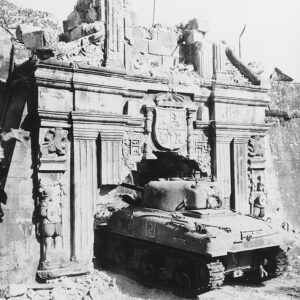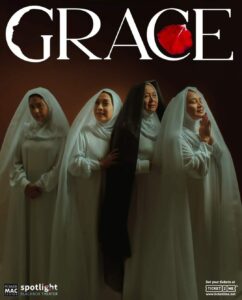The threat from China’s expansive claims in the South China Sea is growing, President Ferdinand R. Marcos, Jr. said last Tuesday, March 19. He said heightened tensions at sea do not serve any purpose, adding that his government always thinks about peace for the national interest.
“We want to do everything we possibly can together with our partners and our allies to avoid that situation,” he said, referring to war with China. When asked about US commitment to defend the Philippines from an armed attack in the South China Sea under the PH-US Mutual Defense Treaty of 1951, his response was, “That is precisely what we want to avoid.”
Brother Andrew Gonzalez gave the same counsel 29 years before. On Feb. 12, 1995, he, at the time president of De La Salle, said in his homily at the memorial Mass commemorating the 50th anniversary of the Massacre at De La Salle, “We commemorate this sad event and the war, not to freshen the wounds of memory or to jolt anger and resentment once more, but to remind ourselves of the futility and cruelty of war.”
He enjoined the survivors of the massacre, a few of whom were there, “to ensure that no longer shall we consider war as the solution to the problem of conflict and injustices but as an evil to be avoided at all costs.”
Below is an excerpt from the firsthand account of Fr. Cosgrave, CSSR, the chaplain of De La Salle College at the time, on what happened in that campus on Feb. 12, 1945 to cause Br. Andrew to say war is an evil to be avoided at all costs. There were 68 people residing in De La Salle in February 1945. Among them were 17 La Salle Brothers, Fr. Cosgrave, and residents in the school’s vicinity who sought refuge in the De La Salle building as they considered it safe from shelling because of its reinforced concrete walls and high ceilings. Forty-one, including 16 La Salle Brothers, died in that holocaust.
“On Monday, Feb. 12, 1945, just after we had eaten lunch, all of us gathered for protection from the shelling at the foot of the stairs in the southern wing. A Japanese officer accompanied by 20 soldiers entered and took away two of the house boys whom they had badly wounded. Then the officer gave a command and at once the soldiers began bayoneting all of us; men, women, and children alike.
“Some of the Brothers managed to escape up the stairs. They were pursued by the soldiers, some of them bayoneted at the entrance to the chapel; others within the chapel itself. If anyone resisted, a soldier would fire his gun at them or cut them with his sword. As a result, several, in addition to bayonet wounds, were badly wounded. Some of the children were only two or three years old; a few were even younger. All of those were given the same treatment as their elders.
“When the Japanese had finished bayonetting us they pulled and dragged the bodies and threw them into a heap at the foot of the stairs, the dead being thrown upon the living. Not many were killed outright by the bayonetting, a few died within one hour or two hours; the rest slowly bled to death.”
The event is referred to in the book The Battle for Manila by Richard Connaughton et al, as “Of all the massacres, few were more notorious than that conducted at La Salle College.” The other massacres are described in another book, Rampage by James M. Scott. Here are excerpts from that book:
“Those who were killed by bullets and grenades were the lucky ones. For the rest, the Japanese devised a ruthless means of extermination, one that required imagination and forethought to turn an otherwise ordinary two-story house into a chamber of horrors.
“With brutal efficiency, the Japanese led teenagers and even grandfathers into the kill room, like to the slaughter. The executioners worked with the competence of an assembly line — kneel, chop, fall, kneel, chop, fall.
“And the pile grew, a tangled pyramid of arms, legs, torsos, and heads some attached, others not. Those who survived had to pull out of the way or risk burial beneath the dead.
“The slaughter continued as the afternoon faded to dusk and then nightfall. By then, the jumble of dead was about eight feet high.
“The investigative report into the slaughter of more than 400 men in Paco that Saturday afternoon reads like the script of a horror movie. The evidence clearly establishes a deliberate plan to exterminate all male civilians residing in the area. A more brutal and cold-blooded series of murders can hardly be imagined.”
Other barbarisms committed by the Japanese soldiers during the last days of their occupation of Manila are narrated in the book By Sword and Fire, The Destruction of Manila in World War II 3 February-3 March 1945 by Alfonso J. Aluit. Here are some accounts of the crimes.
“Friday, 9 February 1945: Early this evening, groups of Japanese banged on doors of residences in the area surrounding Plaza Ferguson in Ermita. Tonight, residents of the area filed out of their doors into Plaza Ferguson. The young women and young girls were selected from the assembly, and about 400 of them were herded into the Bay View Hotel nearby, fronting the boulevard.
“The ladies were assigned to rooms in the Bay View, in groups big and small. Many were family groups — mothers and daughters, sisters and aunts, cousins and in-laws. In the group were ladies from old, distinguished families, wealthy and socially elite.
“From this night Bay View Hotel became a joro house, a brothel for the Japanese military. Singly or in groups, Japanese soldiers and marines, sometimes sotted, would come into the rooms where the women were held, and by force and violence take away the one they fancied into any of the rooms in the hotel.
“Saturday, 10 February 1945: This morning the German Club on San Luis Street in Ermita caught fire. Hundreds of refugees in the dugouts under the clubhouse rolled in pandemonium. They were choking from the thick smoke that swept their shelters, but the Japanese shot down those who ran out.
“A delegation of women, cradling suckling babies with small children in tow, approached the Japanese to beg to be let out. They knelt before the troopers to plead in behalf of their families and the other refugees in the compound. Those in the shelters watched in horror as the Japanese bayoneted the children, flung away the babies, and started ripping off the women’s clothes in attempts to abuse them.”
I was only three and half years old when war broke out. Although we were spared the brutalities of the Japanese, still the family lived through the three years of the Japanese occupation in constant fear, uncertainty, deprivation, and hardship. Good thing we, from 87-year-old great-grandfather, to grandparents, parents, sister, and uncles and aunties were all in good health.
I will be 86 in May. I have had a quadruple bypass. I walk with a cane. I have two daughters living with me. One has a stent, the other a transplanted kidney. I dread the thought of us living under conditions very similar to those during the Japanese occupation. I recount here those harrowing stories of Japanese cruelty for the generations born after the war so that they, pampered by the comforts and pleasures of modern-day living into a dubious sense of security because of the iron-clad commitment of Uncle Sam may realize the painful truth that is war.
Oscar P. Lagman, Jr. is an avid reader of Philippine history.






